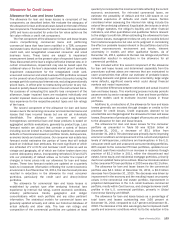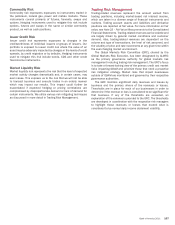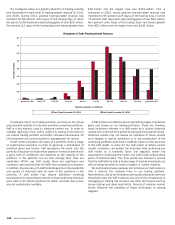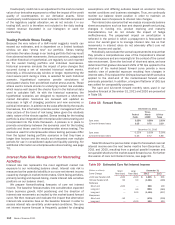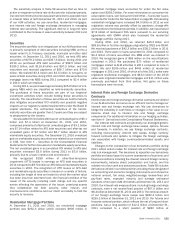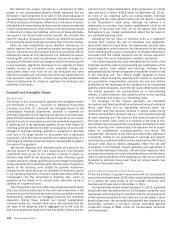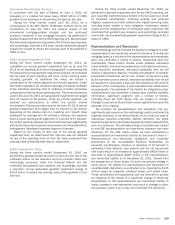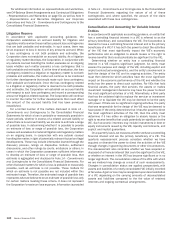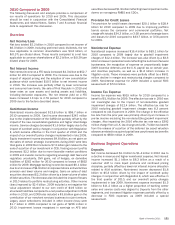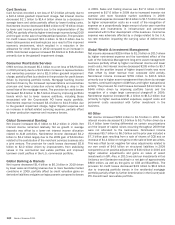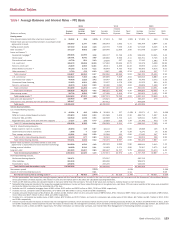Bank of America 2011 Annual Report Download - page 115
Download and view the complete annual report
Please find page 115 of the 2011 Bank of America annual report below. You can navigate through the pages in the report by either clicking on the pages listed below, or by using the keyword search tool below to find specific information within the annual report.Bank of America 2011 113
We use interest rate derivative instruments to hedge the
variability in the cash flows of our assets and liabilities and other
forecasted transactions (collectively referred to as cash flow
hedges). The net losses on both open and terminated derivative
instruments recorded in accumulated OCI, net-of-tax, were $3.8
billion and $3.2 billion at December 31, 2011 and 2010. These
net losses are expected to be reclassified into earnings in the
same period as the hedged cash flows affect earnings and will
decrease income or increase expense on the respective hedged
cash flows. Assuming no change in open cash flow derivative hedge
positions and no changes in prices or interest rates beyond what
is implied in forward yield curves at December 31, 2011, the pre-
tax net losses are expected to be reclassified into earnings as
follows: $1.5 billion, or 26 percent within the next year, 55 percent
in years two through five, and 12 percent in years six through ten,
with the remaining seven percent thereafter. For more information
on derivatives designated as cash flow hedges, see Note 4 –
Derivatives to the Consolidated Financial Statements.
We hedge our net investment in non-U.S. operations determined
to have functional currencies other than the U.S. dollar using
forward foreign exchange contracts that typically settle in less than
180 days, cross-currency basis swaps, foreign exchange options
and foreign currency-denominated debt. We recorded after-tax
gains on derivatives and foreign currency-denominated debt in
accumulated OCI associated with net investment hedges which
were offset by losses on our net investments in consolidated non-
U.S. entities at December 31, 2011.
Mortgage Banking Risk Management
We originate, fund and service mortgage loans, which subject us
to credit, liquidity and interest rate risks, among others. We
determine whether loans will be HFI or held-for-sale at the time of
commitment and manage credit and liquidity risks by selling or
securitizing a portion of the loans we originate.
Interest rate risk and market risk can be substantial in the
mortgage business. Fluctuations in interest rates drive consumer
demand for new mortgages and the level of refinancing activity,
which in turn, affects total origination and service fee income.
Typically, a decline in mortgage interest rates will lead to an
increase in mortgage originations and fees and a decrease in the
value of the MSRs driven by higher prepayment expectations.
Hedging the various sources of interest rate risk in mortgage
banking is a complex process that requires complex modeling and
ongoing monitoring. IRLCs and the related residential first
mortgage LHFS are subject to interest rate risk between the date
of the IRLC and the date the loans are sold to the secondary
market. To hedge interest rate risk, we utilize forward loan sale
commitments and other derivative instruments including
purchased options. These instruments are used as economic
hedges of IRLCs and residential first mortgage LHFS. At December
31, 2011 and 2010, the notional amount of derivatives
economically hedging the IRLCs and residential first mortgage
LHFS was $14.7 billion and $129.0 billion.
MSRs are nonfinancial assets created when the underlying
mortgage loan is sold to investors and we retain the right to service
the loan. We use certain derivatives such as interest rate options,
interest rate swaps, forward rate agreements, Eurodollar and U.S.
Treasury futures, as well as mortgage-backed and U.S. Treasury
securities as economic hedges of MSRs. The notional amounts
of the derivative contracts and other securities designated as
economic hedges of MSRs were $2.6 trillion and $46.3 billion at
December 31, 2011 compared to $1.6 trillion and $60.3 billion
at December 31, 2010. In 2011, we recorded gains in mortgage
banking income of $6.3 billion related to the change in fair value
of these economic hedges compared to $5.0 billion for 2010. For
additional information on MSRs, see Note 25 – Mortgage Servicing
Rights to the Consolidated Financial Statements and for more
information on mortgage banking income, see CRES on page 37.
Compliance Risk Management
Compliance risk arises from the failure to adhere to laws, rules,
regulations, and internal policies and procedures. Compliance risk
can expose the Corporation to reputational risks as well as fines,
civil money penalties or payment of damages and can lead to
diminished business opportunities and diminished ability to
expand key operations. Compliance is at the core of the
Corporation’s culture and is a key component of risk management
discipline.
The Global Compliance organization is responsible for driving
a culture of compliance, establishing compliance program
standards and policies; executing, monitoring and testing of
business controls; performing risk assessments on the
businesses’ adherence to laws, rules and standards as well as
effectiveness of business controls; delivering compliance risk
reporting; and ensuring the identification, escalation, and timely
mitigation of emerging and existing compliance risks. Global
Compliance is also responsible for facilitating processes to
effectively manage and influence the dynamic regulatory
environment and build constructive relationships with regulators.
The Board provides oversight of compliance risks through its
Audit Committee.
Operational Risk Management
The Corporation defines operational risk as the risk of loss
resulting from inadequate or failed internal processes, people and
systems or from external events. Operational risk may occur
anywhere in the Corporation, not solely in operations functions,
and its effects may extend beyond financial losses. Operational
risk includes legal risk. Successful operational risk management
is particularly important to diversified financial services
companies because of the nature, volume and complexity of the
financial services business. Global banking guidelines and
country-specific requirements for managing operational risk were
established in Basel II which require that the Corporation has
internal operational risk management processes to assess and
measure operational risk exposure and to set aside appropriate
capital to address those exposures.
Under the Basel II Rules, an operational loss event is an event
that results in a loss and is associated with any of the following
seven operational loss event categories: internal fraud; external
fraud; employment practices and workplace safety; clients,
products and business practices; damage to physical assets;
business disruption and system failures; and execution, delivery
and process management. Specific examples of loss events
include robberies, credit card fraud, processing errors and physical
losses from natural disasters.
Under our Operational Risk Management Program, we approach
operational risk management from two perspectives to best
manage operational risk within the structure of the Corporation:
(1) at the enterprise level to provide independent, integrated
management of operational risk across the organization, and (2) at


